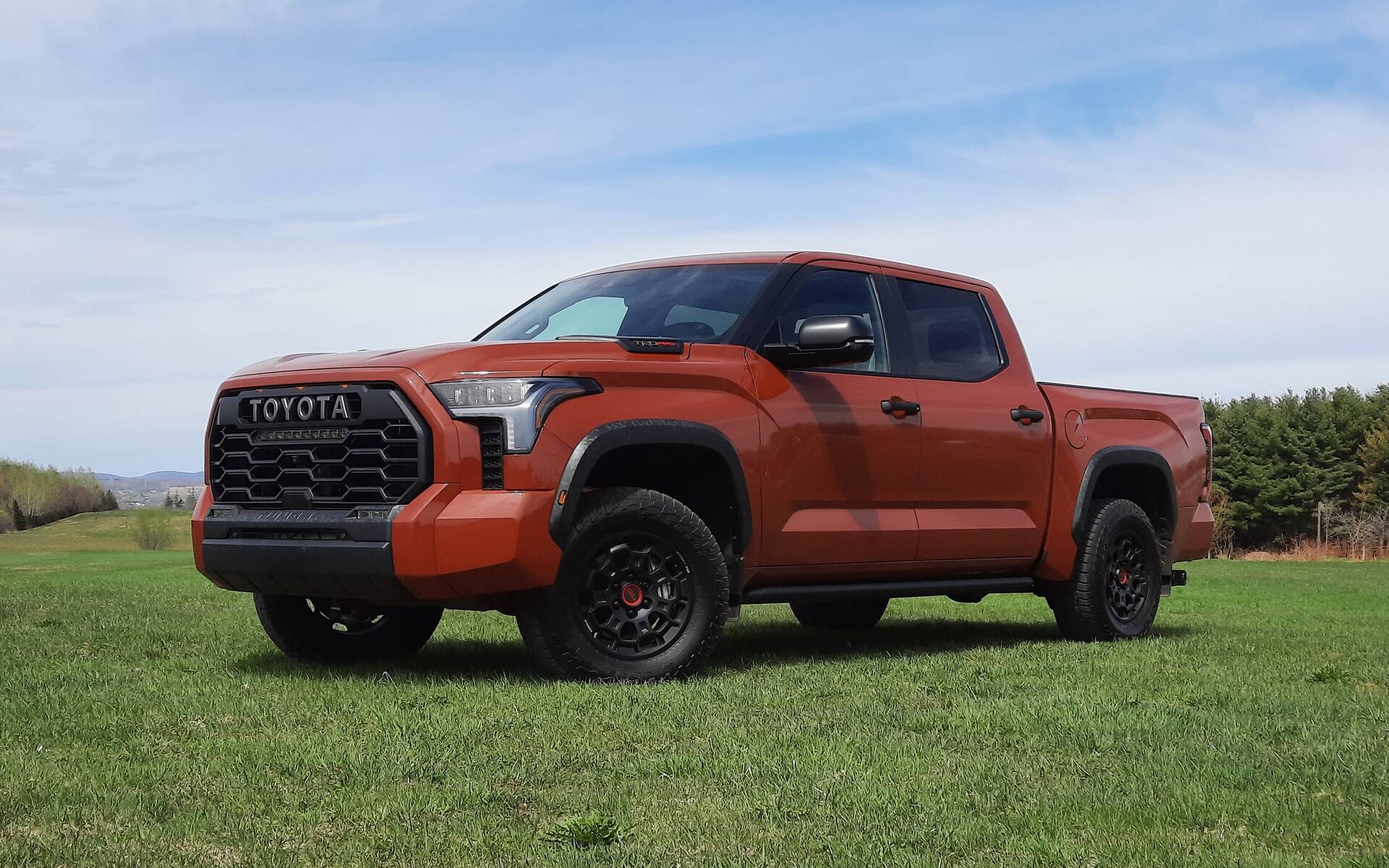2024 Toyota Tundra TRD Pro: Hybrid Muscle FTW

| Strong points |
|
|---|---|
| Weak points |
|
Although it doesn’t have any hopes of ever catching the Americans in the full-size pickup segment, Toyota has wisely leveraged its strengths to stand out from rivals and please the Tundra’s loyal customers. We’re specifically talking about the i-Force MAX hybrid powertrain that’s been available on several models since the launch of the new generation for 2022.
One of them is the fearsome Tundra TRD Pro that we recently put to the test, an off-road beast that takes on the likes of the Chevrolet Silverado 1500 ZR2, GMC Sierra 1500 AT4X, Ford F-150 Raptor (save for the Raptor R) and Ram 1500 Rebel (and to some extent the new 2025 Ram 1500 RHO).
- Also: Transmission Issue Affecting 28,000 New Toyota, Lexus Vehicles in Canada
- Also: Ford F-150 Lightning and Toyota Tundra Go Black for 2024
The Power of Torque
Other than the F-150 Raptor R, none of these competitors generate as much torque as the Tundra TRD Pro. With a fantastic 583 lb-ft, most of which is available at ultra-low revs thanks to the electric motor, initial acceleration is explosive and off-road manoeuvres greatly benefit from it, too. You’d think modulating the throttle would be kind of tricky with so much low-end torque, but it’s not. And we got a real kick out of it.
There’s a lot to like about the 437 horsepower, as well, except that with a weight of more than 2,725 kg, Toyota’s mastodon is significantly heavier and not among the quickest from 0-100 km/h (6.7 seconds based on our previous tests). What’s more, throttle response is almost shockingly slow during on-the-fly acceleration.

Another thing we appreciated was the exhaust note. The TRD dual tailpipes coming out the left side make the twin-turbo 3.5-litre V6 sound awfully like GM’s 6.2-litre V8. Really, it’s easy to be fooled. On top of that, there are many different drive modes to choose from via the convenient multi-terrain selector on the centre console.
The TRD Pro Recipe in 2024
In order to conquer dirt trails, rocky slopes, mud pools and more, the 2024 Toyota Tundra TRD Pro can count on 18-inch forged BBS wheels wrapped in excellent Falken Wildpeak A/T tires, a TRD Pro front stabilizer bar along with a TRD skid plate and rock rails. But more importantly, it features a TRD Pro off-road suspension system with 1.1-inch front lift over the TRD Off-Road model, including 2.5-inch FOX internal bypass coil-overs and rear remote-reservoir shocks.

These rugged components provide plenty of confidence when tackling tough terrain, and there’s still a five-link rear suspension (instead of the usual leaf springs) to stabilize the ride on paved roads. While the LED light bar on the TRD Pro heritage TOYOTA grille is great for venturing into darker spots, the large openings in the mesh grille are an invitation for branches and debris to cause damage behind. You might want to remember that.
While we’re on the topic of design, the Terra signature colour for TRD Pro models in 2024 combined with camo-pattern accents on the front fascia, wheel arches and tailgate give this Tundra a warrior look. To be clear, the TRD Pro badges on both sides of the hood are just that and not functional hood scoops. In the rear, the 5.5-foot cargo bed doesn’t have a spray-on bedliner or those practical corner steps in the rear bumper for easier access. And while there’s a 120V (400W) power outlet available, forget about a 2.4kW or 7.2kW on-board generator like the one Ford offers with the gas-electric F-150 PowerBoost.

Jealous of Its Little Brother
The camo pattern mentioned above can also be found on the seats, the front ones adorned with the required TRD Pro logo. It’s a shame that the most adventurous of all Tundras doesn’t get the wonderful IsoDynamic Performance seats introduced on the new Tacoma TRD Pro (maybe for 2025?). These buckets use an air-over-oil shock absorber system allowing for vertical and lateral seat movement simultaneously to dampen body movement and stabilize the head and neck during more hardcore manoeuvres.
Beyond that, the Crew Max cab is spacious and accommodating, with a large, multi-function console and a 14-inch touchscreen in the middle. The latter makes the information and various camera views easy to see, but at the same time, some of the controls are a bit out of reach. As for the rear bench, which flips up 60/40 for more versatility, the battery from the hybrid system means there’s no storage underneath as is normally the case.

Our Verdict
You’ll need to spend a minimum of $76,000 (including freight, PDI and dealer fees) to get the i-Force MAX powertrain in your 2024 Toyota Tundra, then another $13,500 or so for the TRD Pro package. Don’t bother with the math: this truck is pretty expensive. Premium gasoline is not required but definitely recommended for the twin-turbo V6’s long-term health, which can mean more money to shell out.
By the way, in hybrid configuration, the Tundra is officially rated at 11.7 L/100 km. In TRD Pro trim, it’s 12.3 L/100 km, Natural Resources Canada says. However, the reality is otherwise. Without pushing the truck too much, we wound up with a combined score of 14.3 L/100 km in fair weather conditions.

We faced everything from rush-hour traffic to rocky trails and everything in between but didn’t tow a trailer. For the record, the old V8-powered Tundra burned at least 2-3 L/100 km more than our average.
Unlike the majority of Toyota hybrids, this one makes the most of the technology to increase performance rather than fuel economy. For work and off-road play, it’s definitely better this way. Some competitors offer more gadgets and innovation, but they don’t boast as good a reputation for durability, reliability and resale value. The Tundra TRD Pro’s system still needs to prove itself, but consider it a sound investment.











